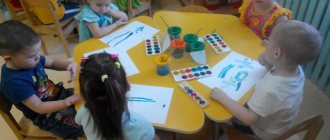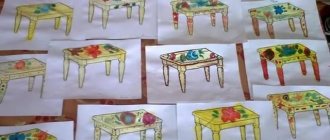On the topic: methodological developments, presentations and notes
Program tasks: Strengthen the skills of drawing elements of Dymkovo painting (circles, dots, stripes, grid, ring, wavy arcs). Strengthen children's ability to create decorative compositions.
Objectives: To teach children to embody their ideas about primroses (snowdrops, scillas) in artistic form. Improve applicative technique. Form compositional skills. Develop feelings
Drawing in unusual ways and using materials that surround us in everyday life evoke great positive emotions in children; they are eager to draw, create and create.
Goal: Drawing a plant - an oak tree. Educational objectives: - Learn to draw plants; correctly convey the structure: oak: a bush plant with blooming red flowers; transmit vel.
Drawing in unusual ways and using materials that surround us in everyday life evoke great positive emotions in children; they are eager to draw, create and create.
Educational activities on artistic and aesthetic development (drawing). Summary of a drawing lesson in the senior group “The house in which I live” Educational field: art.
Source
Progress of the lesson:
I call the children over and ask:
— Guys, do you like to travel ? (Yes)
— What can you go on a trip ? (by car, train, plane)
— What kind of transport do you think can be used to fly to other planets? (on a rocket, spaceship )
— What is the name of a person who makes a space flight ? ( astronaut )
- On April 12, 1961, for the first time a person rose so high that he could “reach out to the stars with his hand”
.
Yuri Alekseevich Gagarin became the first cosmonaut on the planet .
— Now let’s look at the illustrations that depict space . Tell us what we see? (Gagarin, rocket, space station , planets, stars)
- Let's look at the rocket, what parts does it consist of? What does a rocket have? (hull, wings, windows)
.
— Why does the rocket have a sharp tip near the body? (So that the rocket can fly faster, the sharp tip cuts through the air)
— The windows in a rocket are correctly called portholes. “portholes”
together (children repeat the word)
.
— Why does a rocket need wings? (to fly)
.
- How do we know that the rocket is flying? (That's right, fire comes from the wings)
.
— What shape is the body? (rectangular)
.
What shape are the wings and upper body? (triangular)
.
What shape are the portholes? (round)
.
Showing the way to depict a rocket
— First I draw the rectangular body of the rocket. He's quite large. The rocket can fly in any direction you want. Then I triangular tip and triangular wings. Then we draw round portholes. Remember that the rocket body and windows must be different colors so that they do not merge.
I ask the children:
— What else needs to be drawn in outer space ? (moon, stars, planets in outer space )
. I show you how to draw the moon.
Before we start drawing , let's play.
In space through the thickness of years
(They clench and unclench their fingers.)
An icy flying object.
(Raise a clenched fist, tilt it left and right.)
His tail is a strip of light,
( The open fingers of the second hand are attached - the “tail”
.)
And the object's name is comet.
(They clench and unclench their fingers.)
I ask the children:
— Where do you start drawing a rocket ? What shape is the body? What will you draw next? What shape will you draw the wings and tip of the rocket? Besides the rocket, what else can we draw?
When children work independently, if necessary, we use an individual display on our sheet. I use passive actions.
Then I make an exhibition of the children’s work, call the children over and look at the work with them:
- Look at the colorful drawings you have made of your journey .
— Tell me what you drew about your journey ? (I ask several children)
.
- What a great fellow you all are, you did a good job . I liked all your drawings.
"Journey into Space." Summary of a lesson on plasticineography with children 4–5 years old Goals and objectives: 1. Expanding children's knowledge about space, planets and spaceships. 2. To generate interest in the work of creating space. Summary of an integrated lesson in the senior group “Travel into Space” Teacher of the senior group Selyukova V.S. Gostishchevo Purpose: To tell children about the importance of the work of astronauts. Clarify and expand ideas.
Summary of a comprehensive lesson in the middle group “Travel to Space” Preliminary work: – looking at illustrations and pictures, – holding a conversation about space, – asking riddles, – drawing a rocket.
Notes from a teacher-psychologist in the senior group “Journey into Space.” Lesson "Travel to Space". Goals. 1. Strengthen children's knowledge about space. 2. Consolidate knowledge about feelings of joy, sadness, surprise, anger. Summary of a drawing lesson in the senior group “Soldier” Program content: 1. Teach children to create the image of a soldier in a drawing. 2. Learn to convey the characteristic features of a soldier’s costume. Summary of the drawing lesson “They conquered space” Program content: 1. Learn to convey the characteristic features of an astronaut’s figure (posture, costume, attributes). 2. Consolidate children's knowledge.
Synopsis of the role-playing game "Journey into Space" for children of the senior group Synopsis of the role-playing game "Journey into Space" for children of the senior group Irina Vasilievna Tsviklo, teacher of the Nazyvaevsky MBDOU.
Summary of a lesson on mathematical development in the senior group “Journey into space” Summary of a lesson on mathematical development in the senior group. Topic: “Journey into space” Author: Team Tatyana Nikolaevna Purpose: formation.
Summary of a lesson on familiarization with the environment in the senior group “Space” Purpose: To expand children’s ideas about space and its exploration. Objectives: To introduce children to the history of the Cosmonautics Day holiday. Summary of a lesson on sand animation “Journey into Space” for children of senior preschool age Art Studio. Lesson Space. Goal: To consolidate the ability to draw the silhouette of a rocket in flight, to develop the ability to operate with ideas.
Source
Notes on non-traditional drawing for older children. Theme: Space
Notebook on non-traditional drawing on the topic “Travel to Space” for children of the senior preschool group
Author: Salova Elena Viktorovna, teacher, MBDOU - kindergarten No. 7, Yekaterinburg Description: this summary on non-traditional drawing is intended for pupils of senior preschool groups. It will be of interest to educators, additional education teachers and parents. The goal is to create conditions for the development of children's creative abilities through non-traditional drawing. Objectives: Educational objectives:
– introduce unconventional drawing – drawing with napkins;
– consolidate knowledge about space. Developmental tasks:
– to develop the ability to work with non-traditional tools;
– develop children's creative abilities. Educational objectives:
– to cultivate an aesthetic attitude towards planet Earth and space as a whole;
– to cultivate sensitivity to the perception of the beauty of the surrounding world. Planned result: – be able to apply acquired knowledge; – be able to listen carefully and answer questions; - be able to complete assigned tasks. Form of joint activity: gaming, communicative. Form of organization: collective. Integration of educational areas: “Artistic and aesthetic development”, “Cognitive development”, “Speech development”, “Social and communicative development”. Educational and methodological set: Tools: – visual
– illustrations of the Solar system, the view of the Sun and Earth from space;
– equipment
– magnetic board;
– materials and tools
– gouache, paper napkins, album sheets.
Progress of the lesson
Updating children's knowledge
The teacher attracts the attention of children. Educator. Guys, today we are going on a trip with you! But not in a simple way, but in a cosmic way! What should we take with us? Children's answers. Educator. Great! We have collected our things, now we need to get dressed. What do astronauts wear? Children's answers. Educator. That's right, you need to put on a spacesuit. He will protect us and also give us air, because there is no air in space, and a person cannot live without it. Now we have to get on the bike and fly. Right? /no/
Why can’t we ride a bicycle to space?
Children's answers. Educator. Of course, a bicycle cannot fly. And you can only get to space using special transport. What is it called? /rocket/
We are boarding a rocket! Our journey begins!
Finger gymnastics
1,2,3,4,5
(Children take turns bending the fingers of one hand, starting with the little finger, helping with the index finger of the other hand).
We will fly in space
(Children rotate the hand, which is clenched into a fist)
.
1 – comet. 2 – planet. 3 – lunar rover. 4 – starship. 5 – earth (Children take turns extending their fingers, starting with the thumb)
.
Goodbye friends! (Children wave their hands, as if saying goodbye)
.
Same with the other hand.
Communicative activity
Educator. Guys, look, we are already flying in space! Oh, our porthole is dusty with cosmic dust, let's wipe it down. Children make circular movements with their hands. The teacher places an illustration of the solar system on the board.
Educator. Guys, look how far we have flown. What do we see? Children's answers. Educator. That's right, this is the solar system. At its center is the Sun star, and the planets revolve around it. Who knows what planets are in the solar system? Children's answers. The teacher summarizes the children's answers. Educator. Let's fly a little closer to our Sun? The teacher places an illustration of the Sun on the board - a view in space.
Educator. Look how beautiful and interesting the Sun is when you look at it from space! How would you describe it? Children's answers. Educator. Great, but you and I have flown far from the Earth, I’m afraid we won’t have enough fuel, let’s fly a little closer to the Earth and look at it. The teacher places an illustration of the Earth on the board - a view from space.
Educator. Guys, this is planet Earth! Do you like this look? What is the Earth like, how would you describe it? Children's answers.
Creating a problem situation
Educator. Our Earth is very beautiful! Let's take a picture of her and show our parents what we saw today! Oh, who took the camera? What do we do? How do we capture such beauty? Children's guesses. Educator. That's right, guys!
You can draw the Earth and show it to your parents! Great, but first we'll stretch our legs and arms a little. Motor activity
Children stand in a circle and run after each other.
Fast rockets are waiting for us to fly to the planets.
Whichever one we want, we’ll fly to that one! But there is one secret in the game: (Children squat down)
There is no room for latecomers!
Repeat several times.
Visual activities
Educator. Well done boys! Only we have a small problem again! I took paints on our trip, but forgot about the brushes! But I have one idea! You and I will draw with napkins! Our space is extraordinary and our drawings will be extraordinary too! The teacher explains the progress of the work. Educator. In front of you lies a landscape sheet with the outline of the Earth, a palette and napkins. Educator. Take one piece of napkin and crumple it into a ball. Let's dip it in blue paint and stamp the ocean, but the most important thing is not to smear it, but to print it.
Educator. Next, take another napkin, crumple it too, dip it in brown paint - these are mountains and dry land.
Educator. Next, we print the meadows, forests and fields with green paint.
Educator. The earth is ready. Now we will paint space with purple paint.
Educator. The final touch is to paint distant stars and planets with yellow paint.
Reflection
Educator. Guys, did you like the time we spent with you today? What did you like most? What new did you learn today? Let's take a look at our wonderful works!
We recommend watching:
Unconventional drawing technique Blotography. Master class How to draw a cosmic landscape step by step Drawing with crayons on paper for children from 4 years old Drawing using the TRIZ system in the senior group on the topic: Space
Similar articles:
Drawing autumn leaves, grades 1-2





